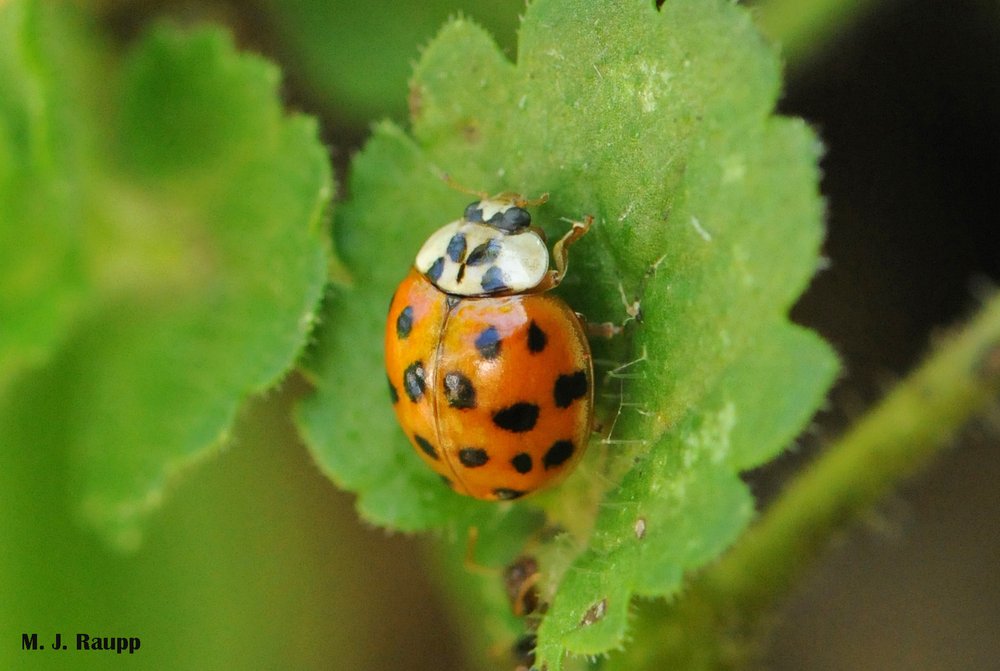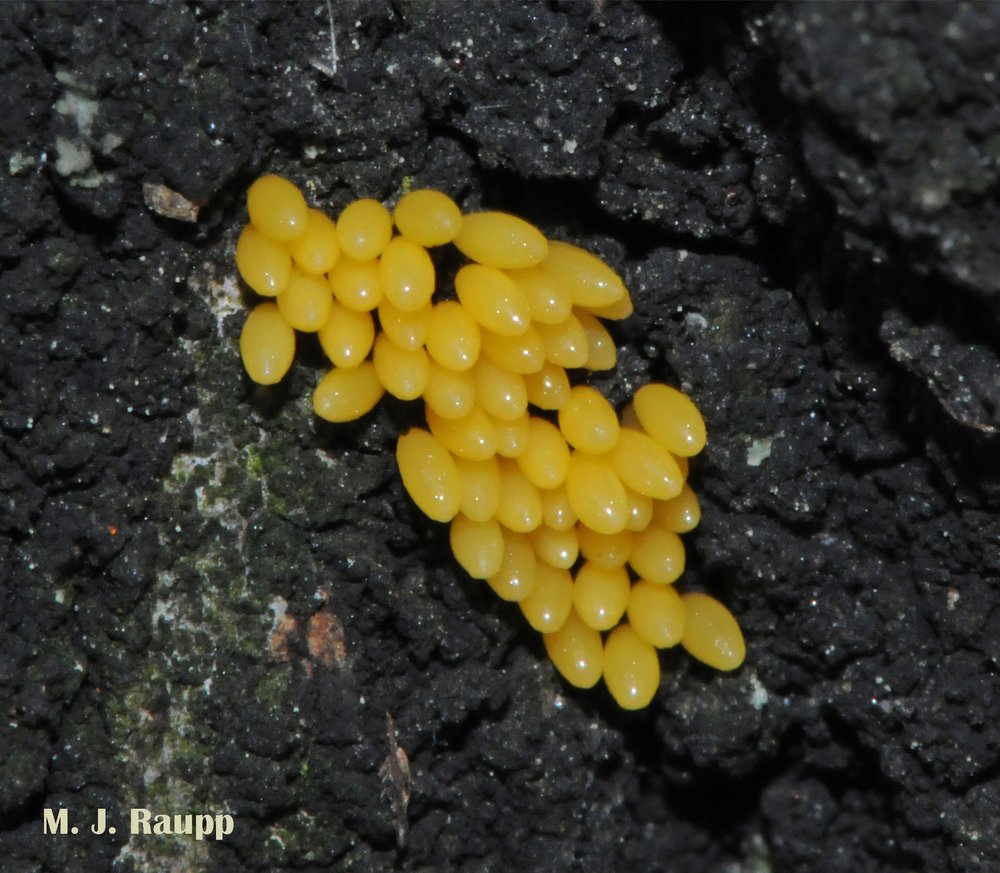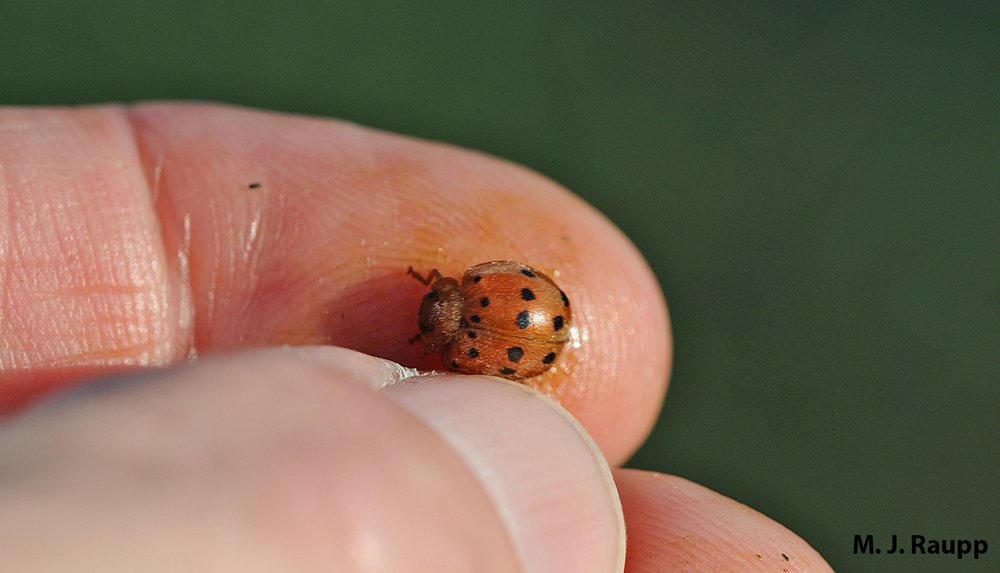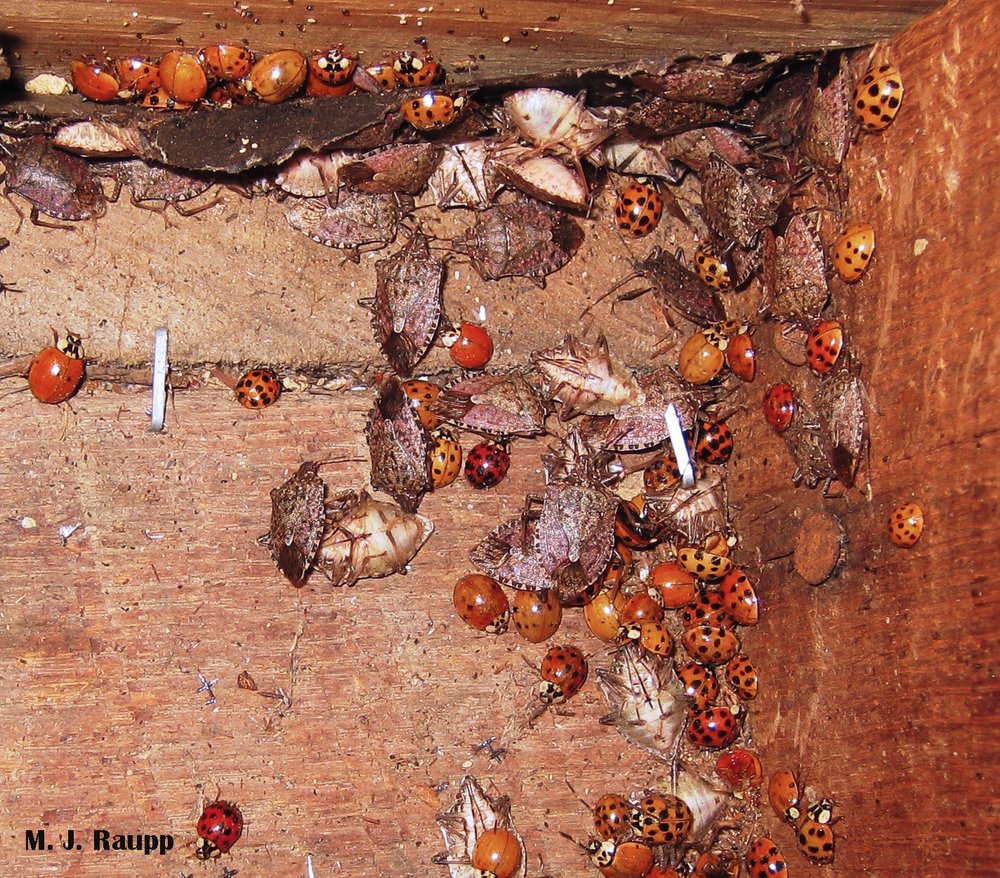What’s in a name? Ladybug, lady beetle, lady bird beetle – meet the home invading Multicolored Asian Lady Beetle, Harmonia axyridis

Just behind the beetle’s head, black markings form the letter M on Harmonia axyridis. This clue helps distinguish the Multicolored Asian Lady Beetle from other species of lady beetles.
During the last week or so numerous reports of home invasions by lady beetles have surfaced with a modicum of confusion about what these creatures are. Misleading headlines like “Ladybug lookalike invading area homes” surfaced. For starters, let’s untangle the moniker thing. The beetles invading homes in many parts of the country during this season belong to a family of beetles called the Coccinellidae. These beetles go by many names – ladybugs, lady beetles, lady bird beetles – and are among the most common beetles in the US. All of these names refer to members of the coccinellid clan, a clade some 5,000 species strong worldwide. The term “ladybug lookalikes” really doesn’t make too much sense as ladybugs and lady beetles are different names for the same group of insects.
Lady beetles, also known as ladybugs and lady bird beetles, are members of a clan more than 5,000 species strong. Many species are important predators helping to reduce pest populations in gardens, landscapes, and crops. The Multicolored Asian Lady beetle, Harmonia axyridis, is a common home invader in autumn throughout much of North America. It seeks overwintering sites in human-made structures. In natural settings, large aggregations form on rocky outcroppings of mountains where they survive winter’s ire. Harmonia was very abundant in parts of the DMV this year, which caused quite a stir with the public.

During her lifetime, a single female lady beetle may lay hundreds of eggs.
The petite invaders recently seen on homes, schools, and office buildings throughout the DMV and in many parts of the country are multicolored Asian lady beetles (a.k.a. Halloween lady beetle) seeking winter refuge. Harmonia axyridis is a prodigious killer of aphids and other nasty pests in our gardens. In one grove of shrubs, I witnessed the annihilation of a booming aphid population. The dazzling lady beetle adults and their alligator-like spawn so completely attacked their prey that I could not find a single living aphid a couple of weeks after Harmonia discovered the aphid patch. Harmonia adults have been reported to consume more than 250 aphids each day, and a single larva may eat more than 1,200 during its development. In addition to eating large numbers of aphids, they devour other pests including adelgids, scales insects, and psyllids.
The alligator-like larva of Harmonia may consume more than 1200 aphids during its development.
Like many predators, they also eat each other. In fact, Harmonia has been implicated in declines of indigenous lady beetle populations on oceanic islands where it has been introduced. As early as 1916, deliberate attempts were made to introduce Harmonia axyridis into the United States from their aboriginal home in Asia, to control aphids. We are not exactly sure how or when this lady beetle established, but by the mid-1980s, it was firmly entrenched in the southern United States. By 1993, it was reported in several Mid-Atlantic States, including Maryland. It is now distributed from Florida to Washington State. Reports of people being “bitten” by ladybugs abound and I confess that I have gotten a small nip from Harmonia every now and then. A recent study discovered that these tiny awesome predators, especially smaller native species of lady beetles, do indeed bite humans and in some cases drink mammalian blood under laboratory conditions. Yikes! Before you duck and cover your jugglers, take solace in the knowledge that Harmonia exhibited no tendency to drink blood.

Not all coccinellids are predators. The Mexican been beetle is an herbivore, but like its predatory relatives it secretes potent chemical defenses from its joints to ward-off predators. These bitter, stinky secretions can stain skin or fabrics.
There are a couple of cautions you might heed as you deal with home-invading lady beetles. When handled or disturbed, lady beetles can release a smelly, bitter secretion that may leave a faint yellow stain on your skin, wall, or curtain. The secretion is a witches’ brew of alkaloids and methoxypyrazines, potent feeding deterrents for would-be predators of lady beetles. There have been reports of pets, particularly dogs, eating lady beetles and becoming ill, so please remind Fido that these are not cicadas and don’t let him eat lady beetles.
Why are there so many lady beetles and what is the fascination with them invading our homes? Remember, these are predators and like many of the other members of their guild, when prey populations increase, populations of predators often follow. With abundant rainfall and lush plant growth providing food for aphids and other juicy prey this spring and summer, it appears that lady beetles had great success finding food, which elevated their survival and reproduction.

In autumn and throughout the winter, Multicolored Asian Lady Beetles and Brown Marmorated Stink Bugs find refuge in protected locations like attics. Many will not survive until spring.
Are these lady beetles simply nosey or are we next on the menu now that the aphids are gone? As winter approaches, Harmonia seek protected locations such as crevices and cracks in rocky cliffs and outcroppings to escape the ravages of winter. Throughout the cities and suburbs of the DMV rocky cliffs are scarce, but homes and buildings are plentiful. Like the brown marmorated stink bug we met in previous episodes, this is the time that Harmonia fly to human-made structures and attempt to find refuge. Any cracks around windows, breaks in stone foundations, unscreened vents in the attic, or gaps in facer boards can allow entry into your home. Once inside the beetles settle-in and become dormant for the winter. Many will dehydrate or starve to death indoors, but on warm days in the late winter and early spring survivors may become active and find their way to sunny windows, where they attempt to escape. To prevent lady beetles and other invaders from entering your home, repair screens on your windows and vents, caulk your foundation, seal air conditioners, and eliminate points of entry to your home. Not only will this keep invaders out, but it will also help keep warm air in and reduce your heating costs. If you find the beetles are a problem indoors, carefully sweep or vacuum them up and release them in a protected spot outdoors such as a tool shed or wood pile.
One of the real delights of the season is to visit nearby summits such as the rocky crags of Old Rag Mountain in Virginia or Sugarloaf Mountain in Maryland to witness legions of multicolored Asian ladybeetles gathering on the sunny cliffs for one last bask in the sun before turning in for the winter. But you better hurry. The arrival of the multicolored Asian lady beetle is a sure sign that Old Man Winter is just around the corner.
Acknowledgements
Bug of the Week thanks Kevin Ambrose whose recent account of Harmonia in the Washington Post provided the inspiration for this episode. The interesting study by Sam Ramsey and John Losey entitled “Why is Harmonia axyridis the culprit in coccinellid biting incidents? “, “The chemical ecology of Harmonia axyridis” by John J. Sloggett, Alexandra Magro, François J. Verheggen, Jean-Louis Hemptinne, William D. Hutchison, and Eric W. Riddick, and “Multicolored Asian Lady Beetle” by Joe Boggs and Susan Jones were consulted to prepare this article.
This post appeared first on Bug of the Week